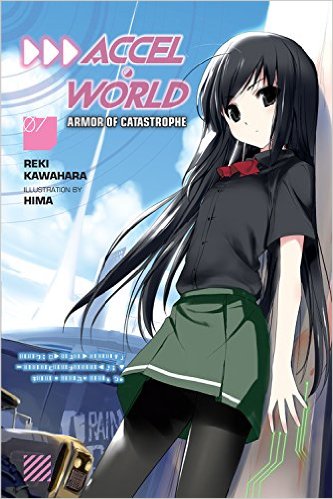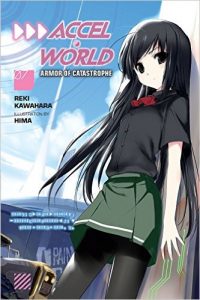By Reki Kawahara and Hima. Released in Japan by ASCII Mediaworks. Released in North America by Yen On. Translated by Jocelyne Allen.
Much as I said last review that this one was probably going to be nothing more than a string of fights, that doesn’t appear to be the case. Bar the beginning, where despite everything Haru and Chiyuri do indeed succeed in punching hope into Takumu, this volume is a bit of breathing room in the midst of what has become a 4-volume arc. What this volume actually ends up being is a giant pile of good times for Haru, as if the author knew that too much bad stuff had rained down on him lately and so is trying to make up for it here. We get the renewed bonds of friendship, some cute ship tease, and finally succeed in busting out of the Accel World version of the Imperial Palace. We even get to see Haru bust some moves in a basketball game. No, really.
And look, another cover image that isn’t Kuroyukihime posing half-naked! (Don’t worry, it’ll be back for the 9th volume.) But yes, part of the plot of this book is to show how to move to the next level with the Incarnate system, and apparently it involved confronting what your worst trait is, and turning it into a positive. No prizes for guessing that Haru’s self-hatred and urge to escape his troubles is his big negative – this is what led to Silver Crow in the first place. But now we start to see him consciously apply what everyone else has always known are his good points – his ability to analyze a situation and come up with an appropriate response, combined with nearly infinite compassion. Let me tell you something, I realize that OT3s don’t actually happen in actual anime/manga, and also that the endgame of this series is clearly (and deservedly) Kuroyukihime. But after reading the first third of this book, you too will believe in the Childhood Friends Threesome of Pure Love.
Then there’s that basketball game. It’s not as if Haru magically becomes a good athlete, or even an average one – he literally works himself into unconsciousness. But this is the first time that we’ve really seen Haru take what he’s learned from fighting battles in the Accelerated World and apply it to real life – not in a cheating sense, but in terms of using his brain to analyze the best course of action. It’s telling that the one actual basketball player on the other team gives him respect – he’s earned it, simply by not giving up immediately and coming up with a solid plan. (They do still lose, I mean this isn’t Sword Art Online.)
Naturally, of course, it all crashes and burns in the end. After escaping from the Castle, we find that the ISS-infected users are busy torturing Ash Roller and his child – and likely doing so until they’re both forced from the game forever. Haru’s compassion is a big positive, but when he sees his friends cruelly tortured, it comes out in the worst possible way – revenge. And so the Chrome Disaster is back, and we have yet another volume to try to resolve this. Kawahara says it’s the last one, he promises. He’s said that before, of course. But I don’t mind. It’s a great arc in an underrated series.





